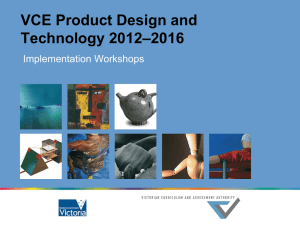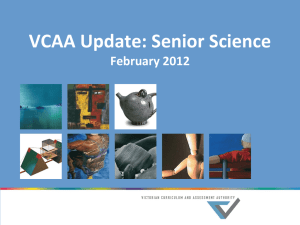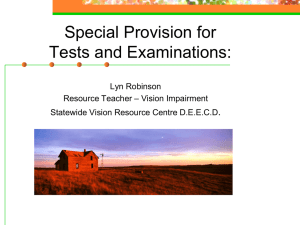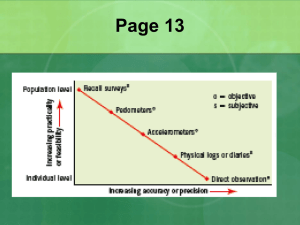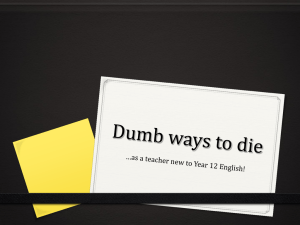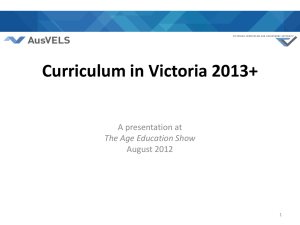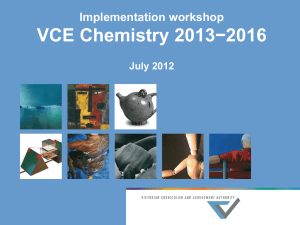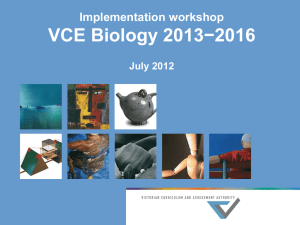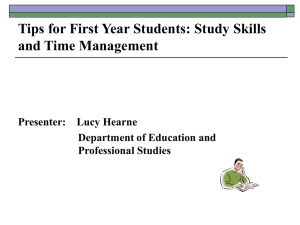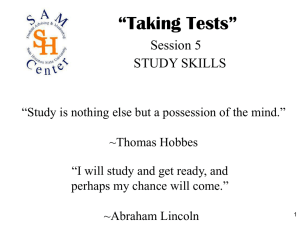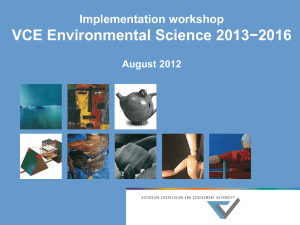THE DOS AND DON*TS OF THE VCE HISTORY EXAMS
advertisement
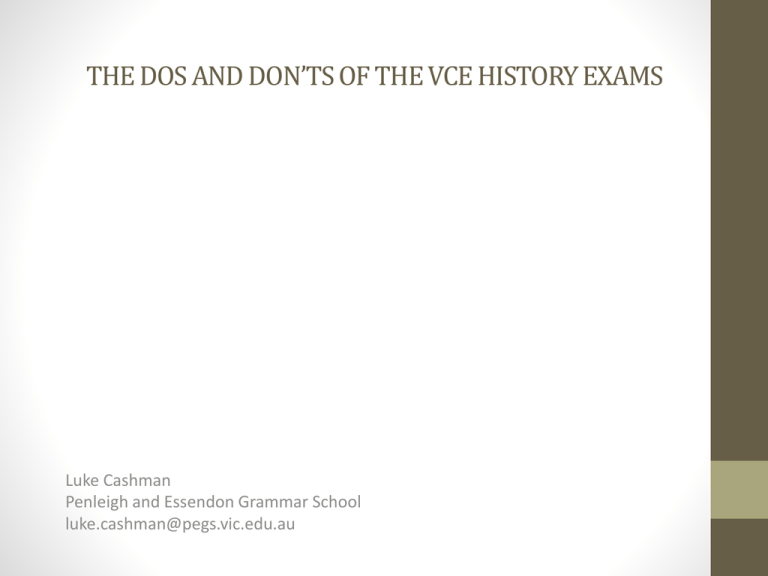
THE DOS AND DON’TS OF THE VCE HISTORY EXAMS Luke Cashman Penleigh and Essendon Grammar School luke.cashman@pegs.vic.edu.au What we will discuss today… • • • • • • • • • • • • • • Know the exam paper How to use reading time effectively Time management during the exam Where to start Addressing the different types of questions What constitutes evidence Tags/triggers Key words Historians’ views What happens if you just don’t know? Nuts and bolts Where to find help What to do next Time for any questions, queries and comments Know the exam paper • Download copies from the VCAA website and study them carefully (including the front page): • Revolutions: http://www.vcaa.vic.edu.au/Pages/vce/studies/history/revolution s/exams.aspx • Renaissance: http://www.vcaa.vic.edu.au/Pages/vce/studies/history/italy/exa ms.aspx • Australian: http://www.vcaa.vic.edu.au/Pages/vce/studies/history/aushistory /exams.aspx • Overall format of the paper: • Renaissance and Australian (Question and Answer Book) • Revolutions (Question Book and Answer Book) Know the exam paper • The weighting of the exam for your subject (50%) • What you can, and cannot, take into the exam room • Where the exam will be held • When the exam will be held: http://www.vcaa.vic.edu.au/pages/vce/exams/timetable.aspx • How much reading time (15 mins) • How much writing time (120 mins) • Do you have to make any choices in the exam paper? • Renaissance: Section C (Florence or Venice) • Australian: Section A (document analysis); Section C (essay); Section D (document analysis) • Revolution (which revolution for Section A; which revolution for Section B?) Know the exam paper • The structure of the paper • For all three subjects: • Four Sections • 20 marks each • 30 minutes on each section • The different types of questions that will be asked in each Section (comprehension, short answer, evaluation, essay etc) • How much time to spend on each question: • • • • Generally, 500 words per section (ie, every 30 minutes) 20 mark questions – 30 mins 10 mark questions – 15 mins 6 mark questions – 10 mins How to use reading time • • • • • 15 minutes in all three exams Best thought of as reading & thinking time Go through the whole paper Make any choices that you need to (Revs and Australian) Start classifying the questions: • • • • Easy Challenging Very difficult What?! • Read written sources thoroughly • Carefully analyse visual sources • Mentally plan responses (based on the order in which you will address them) • Remember that you cannot mark the exam paper in any way during reading time Time management • Be aware of how long you should spend on each Section and each question • Plan when you will move on from a Section or question • Eg: “When it’s 3:45pm I’ll move on to Section B.” • Write your time plan on the front page of the paper • Be aware of the time during the exam: • Look for the clocks in the room when you are seated • Remove your watch and put it on the desk in front of you • Be time disciplined – when your time is up for that question or Section, move on • Make a note to remind yourself to go back to unfinished questions • Leave some time at the end to complete unfinished responses and to check over your work Where do I start? Option 1: • Start with the questions that you can do • Move on to the more challenging ones • Finish with the questions that you find very difficult • Make sure you leave enough time at the end – write little reminder notes for yourself Option 2: • Start with questions related to long written documents Option 3: • Start with the first question and work your way through to the end Option 4: • Chronologically – work your way through the questions based on the historical timeline Which ever option you choose, rehearse it often with practice exams Addressing the different types of questions • Regardless of the question type, apply RUUP: • • • • Read Underline (tags/triggers & key words) Understand Plan • Address ALL key terms in the question • 2 mark questions: • • • • • • • Typically require observation/comprehension Identify elements from the document/s Easy, so get them right!!! Look at the questions before reading the source Mentally answer them in reading time Write in full, albeit brief, sentences Only a few minutes for all of them Addressing the different types of questions • 4 and 6 mark questions: • • • • • • Spend between 6 – 10 minutes (depending on its weighting) Between 80 – 120 words (depending on its weighting) Typically knowledge based questions (ie “Explain how…”) Putting historical events in context (causes, course, effects) Might ask you to refer specifically to a given document Quote a written source or refer to specific elements of a visual source if required by the question • Plan one of your points around a quote/reference to the document to ensure that you can attain full marks for the question • Structure: • Topic sentence (answer the question directly) • Two to four points • Concluding sentence • Use signposting to clearly differentiate between your points • Use specific & relevant evidence to support your points • Be succinct and start answering the question immediately Addressing the different types of questions • 8 - 12 mark questions • • • • • • • • • • Around 12 – 18 minutes 200 – 300 words Typically “evaluate” style questions How useful or reliable is a document in understanding an aspect of the past? Think very carefully about the question and plan your response before you start writing You need to establish a clear argument in response to the question Challenge the source in some way – either unreliable or doesn’t give us the full picture of what actually happened Use specific & relevant evidence to support your point of view Usually asks you to include historians’ views – use these to help support your own argument Use signposting to clearly differentiate between your points Addressing the different types of questions • Essays: • Same conditions in all three papers: • 20 marks = 30 mins (plus any extra time you saved elsewhere) • Approximately 500 ~ 600 words • RUUP • Intro: • • • • About 10% of the essay length A couple of sentences – be brief and succinct A clear contention related to the prompt – have an argument Be nuanced – don’t simply agree or disagree with the prompt • MBPs: • Topic sentence (a clear argument that supports your contention) • Plenty of precise, specific & relevant evidence • Three of about 150 words • Conclusion: • Similar to the intro • Possible structures: • Chronological • PECS (political, economic, cultural, social) • By social group (particularly REVS and REN) What constitutes evidence? • Numbers: • Dates • Statistics (population & demographics, prices, food, casualties, resources, indicators of economic situation etc) • Capital letters: • • • • • • • • Individuals Social groups and organisations (eg the Army) Political parties and groups (eg the Bolsheviks) Important events Places and geographical features Key documents Government policies Ideas and ideologies (eg the Enlightenment) • Also – quotes from primary sources • An historian’s opinion is NOT evidence – it is an argument that needs to be supported with evidence Tags/triggers • Tags/triggers tell you how to answer a question • Examples: • • • • • • • • • • • • Identify (observation & comprehension) Describe (features & aspects) Explain (a process or system, or a sequence of events that led to…) Compare/contrast Analyse (identify arguments & points of view) Evaluate to what extent… (how useful or reliable; a judgment call) Using your own knowledge,… Quoting/referring to documents Referring to historians/other views Using two/three/four points,… To what extent do you agree? (Indicate this clearly!!) Provide evidence to support your response. Key words • Key words tell you what to write about • Examples: • Individuals & leaders • Social groups, movements and organisations • Key dates & important events: • • • • • • • • • • You MUST know the timeline for each AOS Don’t go beyond the range of dates in a question Refer to events that occurred on the dates in the question Make sure you go up to the final date (eg 4 August 1789) Key documents (visual & written) and speeches Government policies, decisions and actions Legislation, laws, constitutions etc Concepts and ideas (eg Marxism; immigration; humanism) Places and locations References to key historians, their arguments and their works Historians’ views • Students find this the most challenging aspect of the History exams • All three exams require an in-depth knowledge, and appropriate inclusion, of historians’ views • Know which questions in the paper require this: • Will be tagged in questions • Check Assessor’s Reports to be certain • Know what historiography is and why you’re required to understand it • For key topics, understand the scope of the historiographical debate: • What are the extremes of the debate? • Who occupies the middle ground? • Be prepared to position yourself somewhere within the debate and justify this with specific & relevant evidence Historians’ views • How to incorporate their views: • Paraphrasing is acceptable • You can write their name in brackets at the end of the reference • Keep quotes brief and incorporate them fluently into your own writing • Refer to specific historians and their arguments • Don’t just refer to historiographical schools (eg Marxists; revisionists etc) • Don’t just list their views; explain and explore them • Where to find them? • Read books by historians; look for their own summaries of the historiographical debates • Go through textbooks • Assessor’s Reports (especially high-level student samples – also good for examples on how to include them) • Past exams (VCAA and otherwise) What to do if you just don’t know… • • • • • • • • • • NEVER leave a question unanswered If you have studied diligently, you will know something Questions can ONLY be drawn from the Study Design Leave it for the end – save enough time (based on its weighting) and make a note for yourself Take a deep breath to calm yourself Read the question again very carefully Apply RUUP Focus on the key words and base your response on them Write as much as you can that is related to the key terms Give it your best shot – you never know what assessors will reward you for Evaluate the extent to which this representation provides a complete depiction of the revolutionary situation in Russia in October 1917.In your response, refer to parts of the representation and to different views of the Revolution. (VCAA exam 2012) The painting by Kochergin presents a fascinating, if somewhat fanciful, depiction of the events surrounding the Bolshevik seizure of power in October 1917. He presents the storming of the Winter Palace as an event of great heroism and struggle, as exemplified by the pose of the anonymous Red Guard in the very centre of the image and the battered gates behind him. In a typical display of Soviet propaganda, it implies that the Provisional Government was toppled by an anonymous mass of workers, soldiers and sailors. While British Marxist Christopher Hill would agree with such a depiction of October, the actual storming of the palace was much less dramatic and something of a non-event. No one, it seemed, was willing to stand up for the Provisional Government (Trotsky). Pipes, however, seeks to undermine the popular legitimacy of the Bolshevik regime by arguing that October was little more than “a classic coup d’etat… with hardly any mass involvement.” Revisionists like Fitzpatrick and Service dispute this view by noting that, as Fitzpatrick writes, “the Bolsheviks’ greatest strength… was the party’s stance of intransigent radicalism.” This made the Bolsheviks by far the most popular political alternative, at least in the industrial centres of Petrograd and Moscow. The image also does little to explain the role of Trotsky, as head of the three-man MRC, in personally planning and staging the October Revolution. Trotsky himself argued that his, and Lenin’s, presence in Petrograd was vital to the success of the Revolution, while Ian D. Thatcher emphasises Trotsky’s preference to seize power in the name of the soviets rather than the Party, which was ultimately more popular. Therefore, while this painting emphasises the role played by the ordinary people of Petrograd in the October Revolution, it places too much importance on them and not enough on the determination and organisation of revolutionary leaders like Lenin and Trotsky. (312 words) Nuts and bolts • • • • • • • • Write your student number first Write in blue or black pen only (especially for Revs as it will be scanned) Take plenty of spare pens in case one runs out Highlighters for marking key words Handwriting – as neat as possible Avoid re-writing and scribbling out Focus on correct spelling, punctuation and grammar Write in a formal and sophisticated manner: • Read historians’ works • Read high-level student samples (Assessor’s reports) • • • • • Get your first sentence/essay introduction right!! Don’t attempt convoluted sentences – be straightforward and direct Write in full sentences Make use of paragraphing (not dot points) Plans will not be graded by assessors Nuts and bolts • Writing space: • Ensure that you write in the correct place • Particularly in the Revolutions Answer booklet • You MUST write within the border as indicated, otherwise it may not scan properly • • • • • • • It’s the number of words that counts, not how many lines you fill Small handwriting – you don’t need to fill all the lines Large handwriting – you can write beyond the lines If you write it, the assessors must read it Best option is to use the extra lines provided in the booklets At the end of your response, write “continued in extra space” Clearly indicate the response being continued in the extra space (eg – Question 1c continued) • Call for an extra booklet if required • Clearly indicate if you continue a response in another booklet • Label the booklets: 1/2 and 2/2 Additional help • VCAA Study Design: http://www.vcaa.vic.edu.au/Documents/vce/history/historysd.pdf • Assessor’s reports on the VCAA website • Chief assessor’s articles in newspapers • Your teacher • Your classmates • Practice exams: • • • • HTAV Insight QATs Cengage What can I start doing now? • Ensure that you have all your resources organised: • • • • • • • • • • • • Textbooks Class booklets and handouts Your notes (fill in any gaps) Copies of SACs and any practice tasks with written feedback Past VCAA exams Exams from other organisations Assessor’s reports on the VCAA website Form study groups with your classmates to share ideas and information Memorise the timeline Compile lists of statistics, leaders & social groups Complete practice exams Increase the degree of difficulty • Typed/by hand (train yourself to write for two hours by hand) • Open book/closed book • No time limit/exam time limits • See your teacher regularly for feedback, advice and assistance
